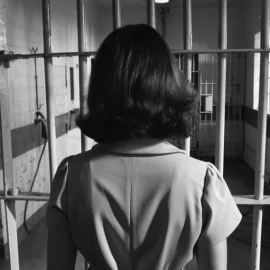
How does someone recover from an experience like the Holocaust? What inspiration can we draw from a life rebuilt?
In her memoir, Dr. Edith Eva Eger provides a profoundly touching and insightful account of her life during the Holocaust. She talks about her time at Auschwitz and her efforts to reconstruct her existence after the war.
Keep reading for an overview of Edith Eva Eger’s The Choice: Embrace the Possible.
Overview of The Choice: Embrace the Possible
Edith Eva Eger, a Holocaust survivor, endured harrowing experiences at Auschwitz. She was coerced to dance for a Nazi officer, faced severe hunger and dehumanization, and saw the body of a girl who tried to escape put on display as a warning to others. Despite the immense suffering, she found ways to cope by holding onto hope, envisioning a future with loved ones, and focusing on her inner strength and resilience.
In The Choice: Embrace the Possible, Edith Eva Eger draws on memories of her family and established relationships to find solace and determination, emphasizing the importance of maintaining a sense of self and connection amidst the dehumanizing conditions of the camp.
Experiencing the Atrocities of Auschwitz
Edith Eger became a prisoner at Auschwitz when she was only sixteen years old. When she arrived at the camp, a prisoner in a striped uniform forcefully removed her earrings. That evening, she was coerced by Nazi officer Dr. Josef Mengele to dance for him.
Gates and guards divided the camp, emphasizing the isolation and separation experienced among various groups. The prisoners suffered from severe hunger, facing a lack of food and running water. A fellow prisoner worried about being able to feed her newborn baby as her milk supply diminished.
Eger faced dehumanization and constant threats. She recalls that a girl who tried to flee the camp was killed, and her body was displayed as a deterrent to others. Eger’s parents and fiancé Eric did not survive Auschwitz.
Coping and Sustaining Optimism
Eger, despite the constant fear of being chosen for execution, shared moments of intimacy by kissing her fiancé Eric and envisioning their future together. They contemplated their future, maintaining hope through plans to attend university, move to Palestine, and pursue their intellectual interests. Keeping a sweet item in one’s pocket, as her father suggested, symbolizes holding onto hope amidst times of despair.
Eger managed the traumatic ordeal by concentrating on enduring and anticipating future liberation, constantly reminding herself that surviving today would pave the way for her liberation tomorrow. She managed her situation by focusing on her dance training and using her creativity to escape the fear enveloping her environment. Eger and her companions maintained their resilience by envisioning a safe haven in their thoughts, a sanctuary that was always reachable even in consciousness. They would engage in food fantasies, imagining cooking and feasting on various dishes as a form of mental diversion and nourishment.
Drawing on Past Experiences and Established Relationships
Eger found solace in her recollections, especially those involving her cherished family members and Eric, which helped her preserve her internal existence and personal identity. Her connection to her sister Magda became a powerful foundation of hope and determination to persevere, as they both lived for each other. A moment of kindness from a Wehrmacht soldier who suggested they ensure they ate offered a slight glimmer of hope.
During her first evening at Auschwitz, Eger had to dance for SS officer Josef Mengele. She envisioned herself performing the role of Juliet in Tchaikovsky’s ballet at the Budapest opera house. Eger discovered she could depend on previously unknown aspects within herself.
Focusing on What’s Within Her Control
Eger realized that while she could not control her external circumstances, she was free in her mind, which Dr. Mengele could never be. The supportive remarks regarding her intellect from her mother gave her a feeling of hope and value. She, along with her fellow prisoners, discovered resilience by engaging in self-dialogue that reinforced their integrity in response to efforts aimed at dehumanizing them.
During a time of extreme vulnerability, Eger concentrated on fortifying her determination by continuously telling herself, “I can do this, I can do this,” thus maintaining a degree of mental autonomy in a situation where she possessed minimal control over external circumstances. Eger highlighted her capacity to impact her environment even amidst chaos by performing gymnastic flips, which not only distracted a guard but also allowed her sister to join her, demonstrating her empowerment in the harsh conditions of the camp.
Eger’s decision to remain with her sister instead of escaping to freedom underscores her dedication to handling her immediate circumstances—staying close to her sister and providing support. She focused on her response to the situation and her capabilities, rather than the overwhelming circumstances outside her influence. Eger developed strategies to survive and achieve freedom while imprisoned at Auschwitz, which she later applied in her career as a clinical psychologist and in her personal experiences. She focused on her ability to choose her reaction to the situations, recognizing her authentic identity when external conditions provided no help or support.
Reconstructing Existence After the Holocaust
Dr. Edith Eva Eger’s significant contributions delve into the arduous process of reconstructing existence following the genocide of World War II, highlighting the obstacles that survivors encountered and the routes they took to achieve meaning and purpose.
Eger emphasizes the stark contrast between the brutal circumstances survivors faced in Auschwitz and their subsequent settings post-liberation, like living in a camp intended for children’s summer activities. The shift to post-Holocaust existence posed many difficulties, as shown by survivors laboring under severe conditions that resulted in physical injuries, such as bleeding hands while handling fibers. Eger often felt guilty for surviving and experiencing joy, struggling with the profound emotional burden of feeling guilty for outliving others.
Survivors such as Eger encountered physical illness and psychological trauma upon returning home, which was sometimes seen as a setback in their recovery. Eger and her colleagues often refrained from talking about their traumatic past, indicating a common avoidance and emotional detachment that functioned as a psychological protective strategy. Eger struggled for many years with memories and feelings of guilt for surviving, frequently pondering how she, despite her vulnerability in her earlier years, managed to endure.
The Desire to Protect Others
Eger’s narrative illustrates her deep dedication to protecting her family from the traumatic event she endured. She worked hard to create a sense of security by fostering a welcoming and safe environment for her loved ones, engaging in daily rituals and seasonal activities to bring joy and stability to her family’s life. Eger deliberately chose not to share her past experiences with her children and friends in order to protect them from the distress those memories could cause. The notion that she might have prevented her mother’s demise haunted her, amplifying her survivor’s guilt.
Pathways to Significance and Intent
Despite the challenges, Eger discovered ways to find significance and fulfillment through remarriage, education, and by assisting others. She married Béla Eger, who did not live up to the romantic ideal she envisioned, yet he emerged as a crucial cornerstone of companionship and support, signifying a significant stage in rebuilding her life. Several close friends of her father, along with her sisters, attended the modest city hall wedding, symbolizing the support from her remaining family and friends.
Eger pursued further education to explore and establish her understanding of life’s significance and her goals after surviving the Holocaust. She composed an essay titled “Viktor Frankl,” remarried Béla following their separation, and chose to teach civics in a disadvantaged area to elevate students who confront challenges akin to her experiences as an immigrant in America.
Addressing Past Issues and Seeking Forgiveness
Eger emphasizes that forgiveness played a crucial role throughout her journey towards recovery. She views forgiveness not as a validation of the oppressors’ actions, but as a personal measure that frees her from the bitterness and grief that tie her to those painful memories. Addressing her past experiences and recognizing that granting forgiveness was crucial to avoid letting those events spoil her future. Eger’s journey from captivity, through her release, to achieving genuine liberation was characterized by her dedication to healing her pain and embracing forgiveness.
Edith Eger’s Healing Methods and Principles
Dr. Edith Eva Eger’s transformation from a Holocaust survivor to a respected psychologist exemplifies the resilience and strength inherent in human nature, along with the profound impact of self-acceptance and conscious choices.
Cognitive Behavioral Therapy
Eger utilizes a therapeutic method that combines various methodologies and techniques, focusing on understanding and cognitive processes, which are varied and intuitively directed. She underscores the significance of embracing individual choices and acknowledging oneself to conquer challenges and the notion of victimhood. Eger’s research merges findings from positive psychology, cognitive-behavioral therapy, and steadfast self-affirmation. She advocates for substituting detrimental beliefs with supportive ones to encourage development. Eger’s therapeutic approach is centered on guiding individuals to understand the roots and persistence of their self-defeating behaviors, aiding them in acknowledging these patterns, and identifying the sacrifices necessary for liberation, as freedom inherently involves certain sacrifices.
Cultivating Personal Independence and Self-Recognition
A fundamental aspect of Eger’s therapeutic approach is understanding the importance of accepting oneself and making choices. She encourages people to embrace their authentic identity and reduce their reliance on others’ approval. Eger’s approach emphasizes self-acceptance and progressively fosters self-appreciation, which ultimately results in transformative outcomes. She supports a specific method for managing emotions: observe, acknowledge, examine, and persist, which involves identifying the emotion, accepting it, evaluating how the body reacts, and staying with the emotion until it changes or fades away.
Finding Inspiration in Eger’s Experience
Eger utilizes her personal experiences and the insights she has gained to support those she helps. She imparts her personal journey of overcoming adversity and recovery to motivate and assist those she values, helping them manage their emotions and experiences. Eger encourages patients to engage in conversations with their younger selves to foster self-compassion and understanding. She promotes the concept that embracing one’s identity and taking charge of one’s decisions leads to liberation.
Transforming Past Experiences and Future Perspectives
Eger assists her patients by drawing on her own experiences to aid them in reinterpreting their past and future perspectives. She delves into the idea of feeling confined by our own thoughts and illustrates ways to uncover the route to freedom. Eger supports her patients by aiding them in reshaping their past and future, playing a vital role in their recovery process. She is requesting to adopt a practical approach to recovery, which she presents through “The Gift,” leveraging her personal and professional experiences.
Dr. Edith Eva Eger’s profound impact within psychology and on her patients’ lives continues to inspire and offer hope to those seeking to overcome their traumas and live freely with various choices.
Journey Toward Freedom for Edith
Dr. Edith Eva Eger’s memoir profoundly examines how the resilience of the human spirit enables it to overcome extreme hardships.
Suppressing Memories and Feelings
Eger struggled with the intense discomfort and lack of sensation resulting from her traumatic Holocaust experiences. She went through phases when she could not recognize her own painful experiences or recall the sensation of tasting bread. The reluctance of Eger and her sister Magda to engage in physical contact, due to their physical state and related psychological scars, demonstrates their struggle with trauma. The siblings’ hesitance to withhold their experiences to shield Klara from the horrors they faced underscores their struggle to find meaning following the distressing events.
Eger employed her personal recovery experience to assist others on their healing path. She pursued counseling to address her son’s developmental issues and her personal challenges. Despite earning her psychology degree with distinction, Eger experienced a deep sense of disgrace and unworthiness, indicative of deeper issues stemming from feelings of guilt for surviving and struggles with her own value. She realized that neither her achievements nor her own efforts were the key to her liberation, understanding that it was solely up to her to reclaim what she had lost.
Seeking Validation Through External Achievements
In her early years as an immigrant, Eger suppressed her memories and avoided discussing her experiences in the concentration camp to prevent pity and gain acceptance. Eger struggled with the fear of being detected and punished by her captors, indicating suppressed memories and ongoing trauma. Despite her professional success, Eger needed to tap into her authentic identity, which involved addressing her personal trauma and utilizing it to empathize with and understand her patients. She understood the value of gaining insights from her own experiences rather than seeking accolades or external validation for her achievements.
Addressing Discomfort and Taking Accountability
Eger experienced deep anguish as she confronted and discussed her past anxieties and the things she had lost. She must acknowledge her feelings and cease to suppress them, as this is essential for her journey towards freedom. She reconciled her emotions, recognizing them as personal and releasing them. Eger’s story implies that she confronted her suffering by enduring daily and sustaining a determination to continue living, which reflects her taking charge of her own survival.
Fully Engaging With the Current Moment
Eger’s path to genuine liberation involved overcoming the obstacles that restrained her, a challenging yet rewarding endeavor. She emphasizes the significance of confronting discomfort and taking responsibility during the recovery phase. She promotes forgiveness, embracing the present, and finding one’s purpose as pathways to freedom. Eger acknowledges that she still experiences nightmares and opts to hold onto affection and optimism despite past suffering. She achieved complete recovery and self-forgiveness 35 years after her initial visit when she revisited Auschwitz. Her journey toward forgiveness allowed her to concentrate on the present and uncover her purpose. Eger realized that embracing her past experiences would lead to her liberation, and that evading these memories implied she had opted to surrender her freedom.






